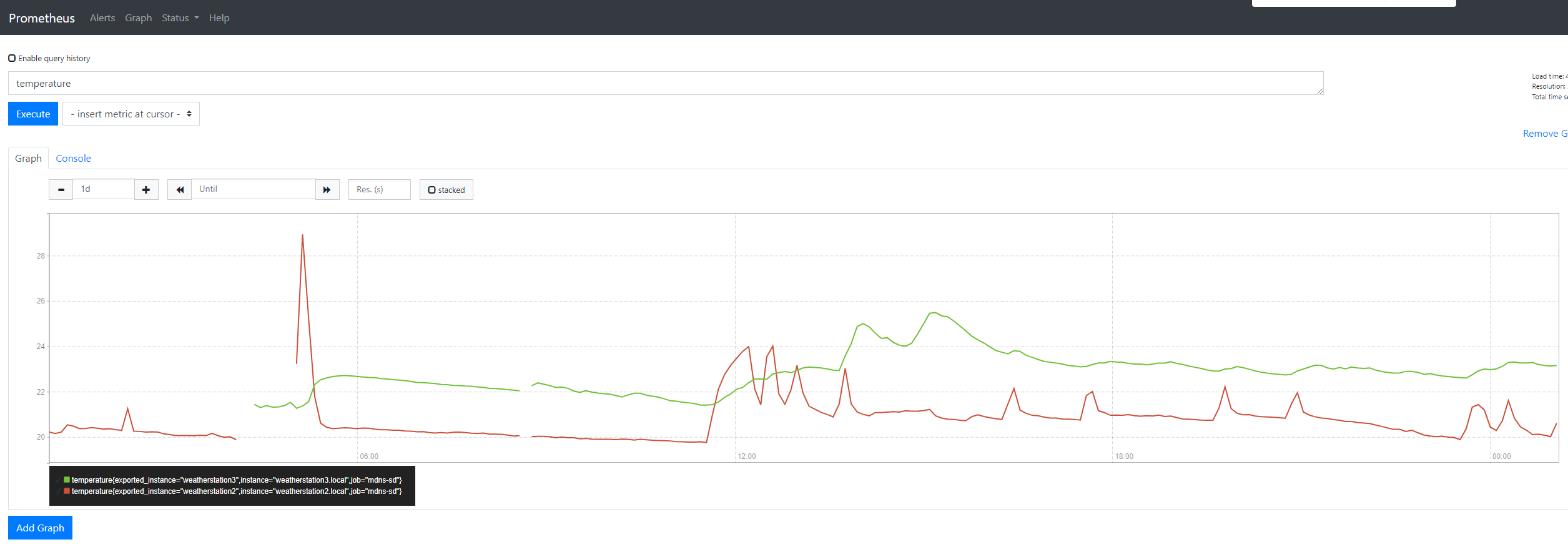Weatherstation/Weather Station March 2023: Difference between revisions
From Federal Burro of Information
Jump to navigationJump to search
No edit summary |
No edit summary |
||
| (3 intermediate revisions by the same user not shown) | |||
| Line 211: | Line 211: | ||
// MDNS.update(); | // MDNS.update(); | ||
</pre> | </pre> | ||
<hr> | |||
wifi_secrets.h would look something like this: | |||
<pre> | |||
#define SECRET_SSID "FBI Van" | |||
#define SECRET_PASS "candyisfree" | |||
</pre> | |||
[[image:temperaturedata.png]] | |||
Latest revision as of 00:48, 4 April 2023
Features / improvements
- MDNS for discovery of web service.
- Moved Secrets to include file.
- removed serial requirement, so it can run "headless"
- moved from esp12 hardware to esp32 hardware. - note less elegant web code, not handler based.
- Dsiabled neopin lighting.
#include <Wire.h>
#include <SPI.h>
#include <Adafruit_Sensor.h>
#include "Adafruit_BME680.h"
#include <WiFi.h>
#include <ESPmDNS.h>
#include "wifi_secrets.h"
#define HOSTNAME "weatherstation3"
char ssid[] = SECRET_SSID;
char password[] = SECRET_PASS;
#define SEALEVELPRESSURE_HPA (1013.25)
#define I2C_SDA 0
#define I2C_SCL 1
WiFiServer server(80);
// Variable to store the HTTP request
String header;
Adafruit_BME680 bme;
unsigned long currentTime;
unsigned long previousTime;
const long timeoutTime = 2000;
void handleMetrics( WiFiClient client) {
// digitalWrite(LED_BUILTIN, HIGH);
Serial.print("request: metrics");
// delay(1000); // wait for a second
Serial.print("bme.performReading()");
if (! bme.performReading()) {
Serial.println("Failed to perform reading.");
// server.send(200, "text/plain", "Failed to perform reading.");
return;
}
Serial.println("Reading done, sending....");
// # HELP temperature Temperature in Celcius"
// # TYPE temperature guage")
String message = "temperature{instance=\"";
message += HOSTNAME;
message += "\"} ";
message += bme.temperature;
message += "\n";
// Serial.println("# HELP barometric_pressure in hectopascals (hPa)"
// Serial.println("# TYPE barometric_pressure guage")
message += "barometric_pressure{instance=\"";
message += HOSTNAME;
message += "\"} ";
message += (bme.pressure / 100.0);
message += "\n";
// Serial.println("# HELP humidity relative humidity percent (%)"
// Serial.println("# TYPE humidity guage")
message += "humidity{instance=\"";
message += HOSTNAME;
message += "\"} ";
message += bme.humidity;
message += "\n";
// Serial.println("# HELP gas_resistance Gas Resistance in KOhms"
// Serial.println("# TYPE gas_resistance guage")
message += "gas_resistance{instance=\"";
message += HOSTNAME;
message += "\"} ";
message += (bme.gas_resistance / 1000.0);
message += "\n";
// Serial.println("# HELP approximate_altitude in meters KOhms"
// Serial.println("# TYPE approximate_altitude guage")
message += "approximate_altitude{instance=\"";
message += HOSTNAME;
message += "\"} ";
message += bme.readAltitude(SEALEVELPRESSURE_HPA);
// message += "\n";
Serial.println(message);
client.print(message);
// server.send(200, "text/plain", message);
}
void handleNotFound() {
Serial.println("handleNotFound: not found");
// server.send(404, "text/plain", "Not found");
}
// the setup function runs once when you press reset or power the board
void setup() {
Wire.setPins(I2C_SDA, I2C_SCL);
// initialize digital pin LED_BUILTIN as an output.
pinMode(LED_BUILTIN, OUTPUT);
digitalWrite(LED_BUILTIN, LOW);
Serial.begin(9600);
// while (!Serial);
Serial.println(F("begin wifi"));
WiFi.mode(WIFI_STA);
WiFi.begin(ssid, password);
Serial.println(F("wifi begined, wait for connected"));
while (WiFi.status() != WL_CONNECTED) {
delay(500);
Serial.print(".");
}
Serial.println(F("connected"));
Serial.println("");
Serial.print("Connected to ");
Serial.println(ssid);
Serial.print("IP address: ");
Serial.println(WiFi.localIP());
if (!MDNS.begin(HOSTNAME)) {
Serial.println("Error setting up MDNS responder!");
while(1){
delay(1000);
}
}
Serial.println(F("BME680 begin"));
if (!bme.begin()) {
Serial.println("Could not find a valid BME680 sensor, check wiring!");
while (1);
}
Serial.println("setting over sampling");
bme.setTemperatureOversampling(BME680_OS_8X);
bme.setHumidityOversampling(BME680_OS_2X);
bme.setPressureOversampling(BME680_OS_4X);
bme.setIIRFilterSize(BME680_FILTER_SIZE_3);
bme.setGasHeater(320, 150);
Serial.println("set over sampling");
Serial.println("web server begin");
server.begin();
Serial.println("HTTP server started");
MDNS.addService("http", "tcp", 80);
}
void loop() {
WiFiClient client = server.available();
if (client) { // If a new client connects,
currentTime = millis();
previousTime = currentTime;
Serial.println("C"); // print a message out in the serial port
String currentLine = ""; // make a String to hold incoming data from the client
while (client.connected() && currentTime - previousTime <= timeoutTime) { // loop while the client's connected
currentTime = millis();
if (client.available()) { // if there's bytes to read from the client,
char c = client.read(); // read a byte, then
// Serial.write(c); // print it out the serial monitor
header += c;
if (c == '\n') { // if the byte is a newline character
// if the current line is blank, you got two newline characters in a row.
// that's the end of the client HTTP request, so send a response:
if (currentLine.length() == 0) {
// HTTP headers always start with a response code (e.g. HTTP/1.1 200 OK)
// and a content-type so the client knows what's coming, then a blank line:
client.println("HTTP/1.1 200 OK");
client.println("Content-type:text/html");
client.println("Connection: close");
client.println();
if (header.indexOf("GET /metrics") >= 0) {
handleMetrics(client);
//stuff
} else {
Serial.println("UNRECOGNIZED CALL");
}
// client.println("<p>GPIO 27 - State " + output27State + "</p>");
break;
} else { // if you got a newline, then clear currentLine
currentLine = "";
}
} else if (c != '\r') { // if you got anything else but a carriage return character,
currentLine += c; // add it to the end of the currentLine
}
}
}
// Clear the header variable
header = "";
// Close the connection
client.stop();
Serial.println("Client disconnected.");
Serial.println("");
}
}
/*
Serial.println("loop start");
delay(1000); // wait for a second
digitalWrite(LED_BUILTIN, HIGH); // turn the LED on (HIGH is the voltage level)
digitalWrite(LED_BUILTIN, LOW); // turn the LED off by making the voltage LOW
*/
//server.handleClient();
// MDNS.update();
wifi_secrets.h would look something like this:
#define SECRET_SSID "FBI Van" #define SECRET_PASS "candyisfree"
